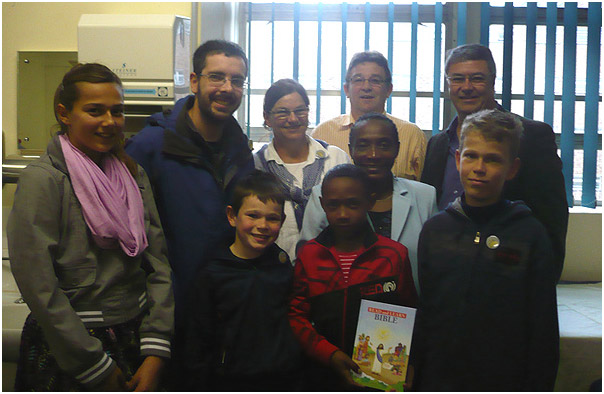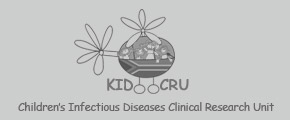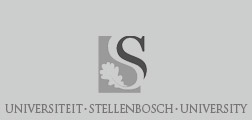NEWS ARCHIVE
Donation of Bibles to KIDCRU - 3 October 2012
In February this year the idea for this project started in church one Sunday morning. Ds. Quintus Heine who is the secretary of the Bible Society of South Africa, spoke about various projects involving the Bible Society at the morning sermon.
The patients at KIDCRU range between newborns to 8 year old’s. The Parks congregation Sunday School children in Kraaifontein under the leadership of Chris Groenewald and Babs van Wyk, as well as Philma Martins from KIDCRU, started the WORD-project in the second semester. More than R14000 has been collected with their collection tins.
The 3rd of October 2012, 300 Children’s Bibles were handed to KIDCRU to distribute between the patients. On this occasion the CAB (Community Advisory Board) members explained what their goal is and the Sunday school children had the opportunity to distribute the Bibles themselves.
Every pediatric patient will receive a Bible at his/her next visit to KIDCRU and can choose from English, Afrikaans and Xhosa languages.

__________________________________________________________________________________
Treating infants with HIV early, and then interrupting their treatment, leads to better results than deferring initial treatment
New research findings show that treating infants with HIV early, and then giving them a break from treatment, leads to better results than waiting until they get sicker to start them on treatment. These findings from the CHER trial were presented at the Conference on Retroviruses and Opportunistic Infections in Seattle on 6th March 2012.
Infants with HIV are at a high risk of dying or their disease getting worse while they are infants. Early treatment with antiretroviral therapy (ART) helps to prevent this. However, treating infants with ART has its own problems: starting children on ART is a lifelong commitment, and costs money. The drugs can have side effects. Their disease may develop resistance to the drugs that are currently available, and the earlier they start treatment the more time there is for resistance to develop.
The CHER (Children with HIV Early antiretroviral) trial was set up to test whether starting infants on treatment early, but then stopping their treatment for a while, could help to reduce these problems. Researchers split 377 HIV-infected children randomly into three groups:
• those who did not start treatment until their disease got worse (standard treatment), but did not interrupt their treatment once they had started
• those who started treatment straight away and stopped after one year, restarting when their disease got worse
• those who started treatment straight away and stopped after two years, restarting when their disease got worse
Researchers followed up these children for up to six years, to study long term outcome.
The trial found those infants who started ART straight away for one or two years, and then stopped, were more likely to live & be in good health by their 5th birthday than those who did not start treatment until later. For the latter, the average time to start ART was 20 weeks on study. Children who had ART straight away for two years and then a break were 40% less likely to have died or their disease to have got worse by the end of the study than those who started treatment later. The results also suggest that the children who had early ART for two years could have a longer break from treatment before their disease got worse than those who had early ART for only one year.
Mark Cotton of Stellenbosch University, one of the principal investigators of the trial said: “These results are very encouraging, as they reinforce the importance of starting infants with HIV on treatment early. Early treatment followed by a break may become an accepted strategy in the future. It is definitely better and more cost-effective than delaying starting infants on treatment.”
Di Gibb, professor in epidemiology and investigator for the CHER trial at MRC CTU said: “The study indicates that if you have limited money for treating children with HIV, starting them on treatment early for the first year or two will save more lives than if you had used the money to treat them continuously but waited until early signs of deterioration before starting.”
The results presented at the conference are preliminary, and further details will be available when the results are published in a peer-reviewed journal later this year. Before these results lead to changes in practice, we need information about the effect of these treatment breaks on levels of the virus in children’s blood, and resistance to ART. These results should be available from the CHER trial later this year.
Very early results from the trial have already had an impact across the world, as back in 2008 they led to a change in the World Health Organisation’s guidelines. Instead of waiting until an infant’s diseases gets to a certain level before starting treatment, treating infants immediately was shown to reduce death. The new long-term results reinforce these early results by now showing that early treatment for one or two years and then stopping is better than waiting. They provide encouragement that for some children treatment can be stopped safely for some time, if the child’s health and immune system is monitored well.
Avy Violari of the University of Witwatersrand in South Africa, also a principal investigator on the trial, said: “The next stage might be to compare early treatment followed by a break with early continuous treatment, to see which strategy is better for children. We also need to find out what the optimum length of initial treatment is. In this trial we looked at one year and two years, and two years seemed better. But it may be that treating children for 3-5 years could lead to an even longer break before they need to go back on treatment for life.”
The trial was carried out in South Africa by the Perinatal HIV Research Unit of the University of Witwatersrand, the Children’s Infectious Disease Clinical Research Unit of Stellenbosch University, and MRC Clinical Trials Unit, as part of the CIPRA-SA programme. The CHER is the first and longest randomized trial assessing practical strategies (that can be implemented in low and middle income countries) for the management of infants with HIV and that its encouraging results highlight the importance of rolling out testing for HIV in infancy.
The research was funded by the Division of AIDS, NIAID, NIH and GlaxoSmithKline. NIAID conducts and supports research—at NIH, throughout the United States, and worldwide—to study the causes of infectious and immune-mediated diseases, and to develop better means of preventing, diagnosing and treating these illnesses. News releases, fact sheets and other NIAID-related materials are available on the NIAID Web site at http://www.niaid.nih.gov.


